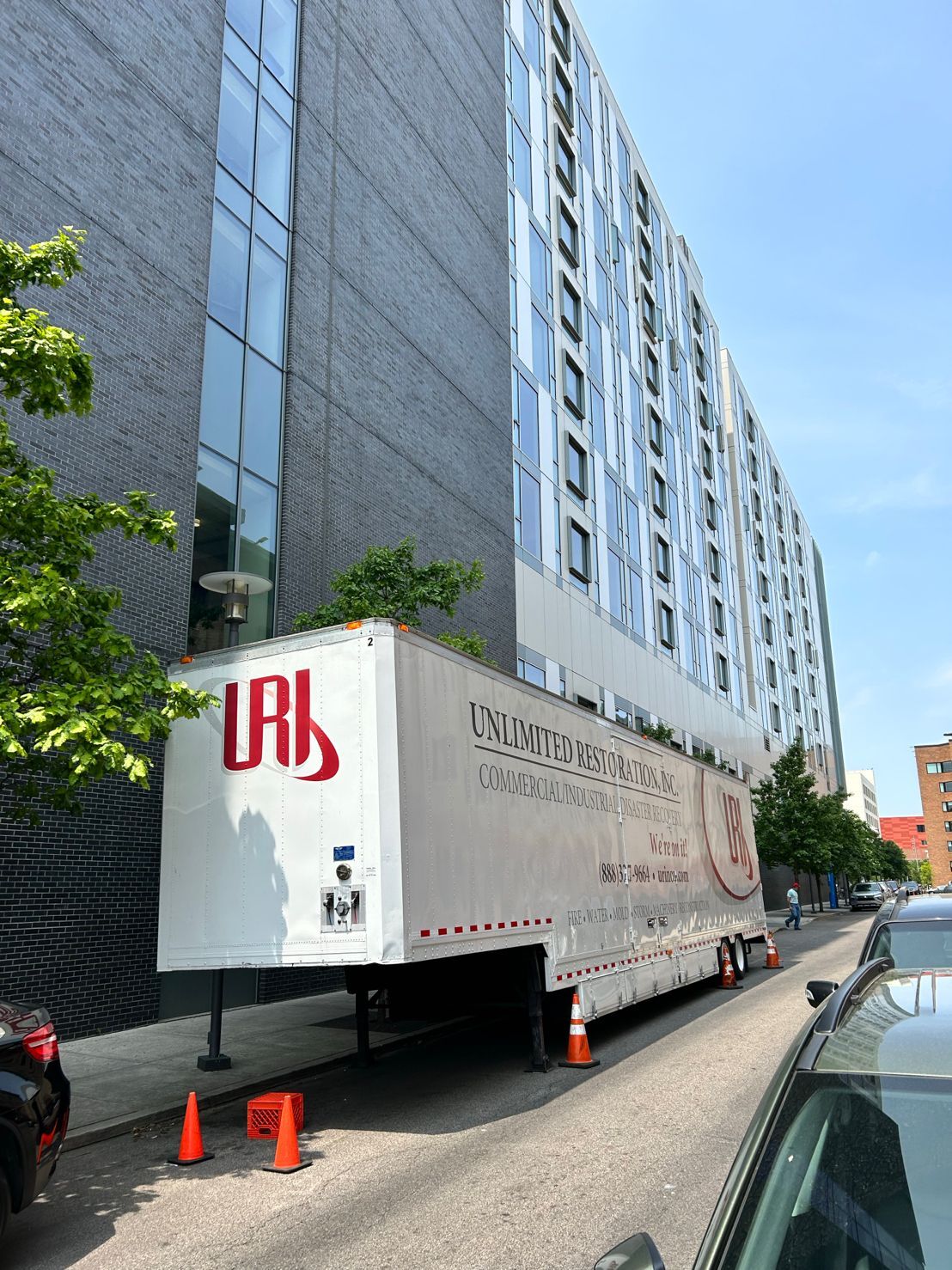
In May 2023, a plumbing mechanical failure let a water main supply loose in a high-rise university student housing building in Philadelphia, PA at 2AM. 19 floors of the building and 220 individual rooms, including high-end dormitory suites, common spaces, elevators, stairwells, and more, were impacted by large-scale water damage.
As an existing, trusted commercial restoration partner for Temple University, URI was called to provide 24/7 Emergency Response for the event. Within an hour, URI was onsite with an extensive equipment arsenal to mitigate damage and start the extraction and drying process.
There were several unique challenges faced by the URI Team of commercial restoration experts on this job, including:
Location
Temple University is located in the heart of north-central Philadelphia, PA, the most populous city in the U.S. Commonwealth of Pennsylvania and the second-most populous city in both the Northeast and Mid-Atlantic regions after New York City. The large-scale loss required the use of URI’s mobile catastrophe response trailers, multiple desiccants/generators, and massive amounts of equipment all that needed to be maneuvered and managed in a major metropolitan area.
High-Rise Building
Nearly 20 floors of the high-rise urban building were affected, and the onsite elevators had extensive damage. URI needed to ensure labor crews, equipment, and other materials were safely delivered up and down numerous flights of stairs for weeks prior to the elevators being back in use. Safety, as with every URI job, was at the top of the priority list and measures were put in place to ensure safe carrying practices and an adequate number of breaks were taken to avoid exhaustion, ensuring the safety of our crew members.
Timeline for Completion
The URI team was under a tight deadline to complete the project before the start of Fall 2023 semester to minimize the impact on the students living in the building as much as possible. Insurance adjusters projected to Temple that they would be back to normal operations in six months, but URI set their sights on completing it in four months or less to ensure a smooth move-in weekend for students come August.
With 19 floors of the university property affected by extensive water damage, Unlimited Restoration provided a multitude of large loss commercial property restoration services, including:
One of the services performed – unique structural drying and use of desiccant dehumidifiers – is highlighted below in more detail, as it required a high level of commercial property restoration expertise and overall project coordination due to numerous intricacies and challenges of this project.
According to Restoration & Remediation (R&R) Magazine: “[Structural Drying] is the removal of excessive, trapped moisture from building materials (both structural and non-structural) in an efficient amount of time. “Structural” can be the word that confuses individuals that are not in the restoration business. This term refers to the part of the building that is crucial to dry without the need for extensive demolition.”
As previously mentioned, all four elevator shafts experienced extensive water damage. The URI Team needed to get creative and enlist some unique structural drying techniques to restore these critical areas of the building, including the use of desiccant drying. Learn more about utilizing a desiccant for a commercial property restoration project below.
How does desiccant drying work?
While desiccant drying is an effective choice, there were a number of concerns that needed to be addressed by the URI team of commercial property restoration experts to ensure safety and efficiency:
Within a week and a half, the URI Team had successfully dried all four elevators, allowing for applicable elevator servicing, cleaning, and resuming of normal operations for this critical area of the building.
While this extremely large-scale water damage restoration project had its unique challenges, the URI Team provided exceptional project management, commercial expertise, and customer service to our partner at Temple University from initial emergency response through post-construction cleaning. By deploying both industry-leading techniques and extraordinary client communication, the URI team helped to minimize disruption for our client which was able to re-open it’s doors to students ahead of schedule, just three months after the initial water loss. This allowed for entirely normal operations for the students’ move-in dates in August.
In October 2023, URI was named the 2022-2023 Business Affiliate of the Year from the Mid-Atlantic Association of College & University Housing Officers (MACUHO) as a result of the completion of this water damage restoration project. Brandon Chandler, MBA, Director of Housing Facilities at Temple University presented the award to URI team members at the MACUHO annual conference and shared a client testimonial that you can check out below.
Unlimited Restoration, Inc. has proudly served commercial property clients, including numerous colleges, universities, and other educational institutions, since 1996 for their property restoration needs.
Should your commercial, industrial, or multi-family residential property experience water damage, you can rest assured with Unlimited Restoration: We’re On It! Call our 24/7 Emergency Response Hotline for immediate assistance: 888.327.9664.
Hired Unlimited Restoration for water damage clean up. They had a team onsite within 90 minutes and kept us informed throughout the process.